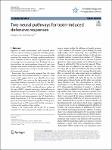Item Infomation
Full metadata record
| DC Field | Value | Language |
|---|---|---|
| dc.contributor.author | Hongyu, Chai | - |
| dc.contributor.author | Peng, Cao | - |
| dc.date.accessioned | 2023-03-16T04:17:35Z | - |
| dc.date.available | 2023-03-16T04:17:35Z | - |
| dc.date.issued | 2023 | - |
| dc.identifier.uri | https://link.springer.com/article/10.1007/s44254-023-00011-9 | - |
| dc.identifier.uri | https://dlib.phenikaa-uni.edu.vn/handle/PNK/6918 | - |
| dc.description | CC BY | - |
| dc.description.abstract | The researchers mapped the projections of AP neurons and found that excitatory and inhibitory AP neurons displayed different projection patterns. Excitatory neurons projected to many brain areas, including the parabrachial nucleus (PBN), nearby NTS, and autonomic motor nuclei, while inhibitory neurons formed connections with AP neurons themselves and partly with NTS neurons. Clusters 2 and 4 primarily projected to calcitonin gene-related peptide (CGRP) + PBN neurons, previously reported as alarm neurons [3]. These results revealed the possible circuit underlying nausea sensation. | vi |
| dc.language.iso | en | vi |
| dc.publisher | Springer | vi |
| dc.subject | calcium sensing receptor | - |
| dc.subject | nausea-associated behaviors | - |
| dc.title | Two neural pathways for toxin-induced defensive responses | vi |
| dc.type | Book | vi |
| Appears in Collections | ||
| OER- Y học- Điều dưỡng | ||
Files in This Item:

